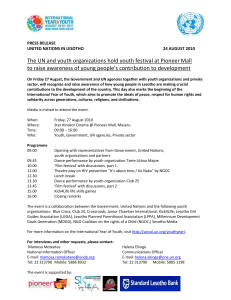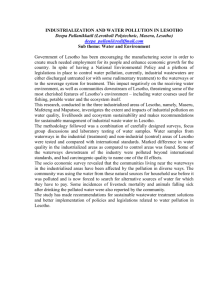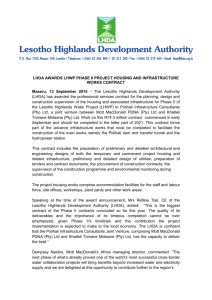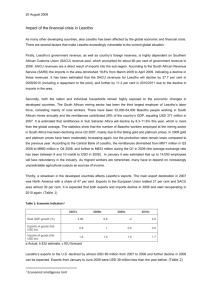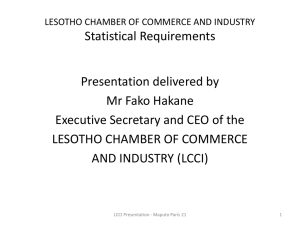HAQ Chapter 7
advertisement
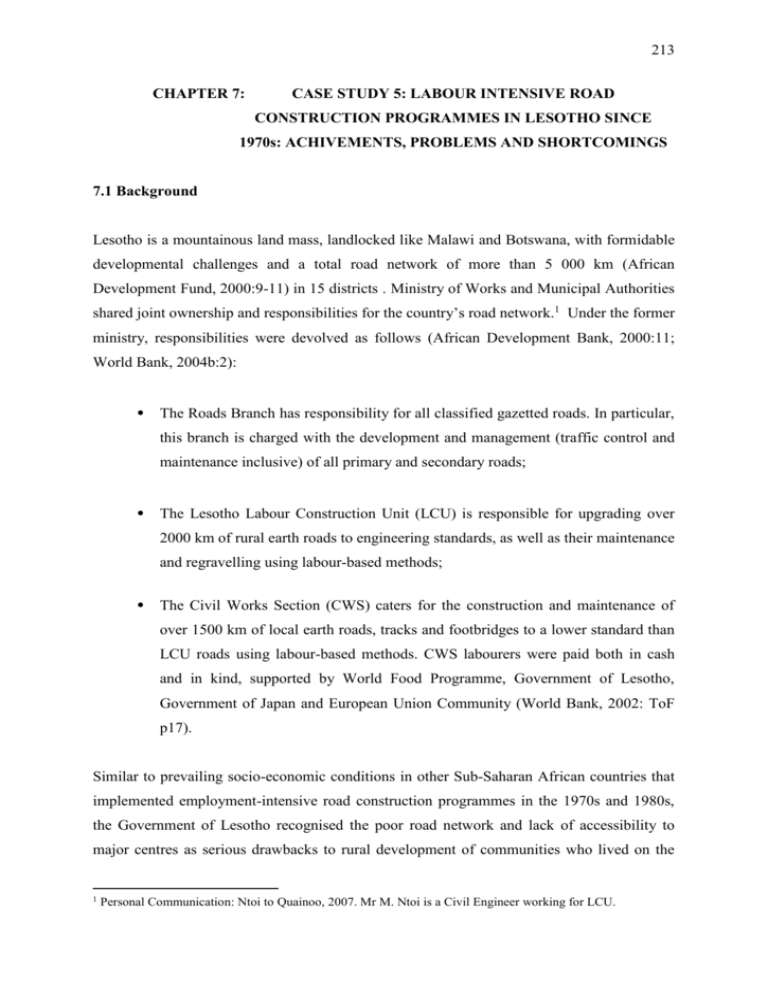
213 CHAPTER 7: CASE STUDY 5: LABOUR INTENSIVE ROAD CONSTRUCTION PROGRAMMES IN LESOTHO SINCE 1970s: ACHIVEMENTS, PROBLEMS AND SHORTCOMINGS 7.1 Background Lesotho is a mountainous land mass, landlocked like Malawi and Botswana, with formidable developmental challenges and a total road network of more than 5 000 km (African Development Fund, 2000:9-11) in 15 districts . Ministry of Works and Municipal Authorities shared joint ownership and responsibilities for the country’s road network.1 Under the former ministry, responsibilities were devolved as follows (African Development Bank, 2000:11; World Bank, 2004b:2): • The Roads Branch has responsibility for all classified gazetted roads. In particular, this branch is charged with the development and management (traffic control and maintenance inclusive) of all primary and secondary roads; • The Lesotho Labour Construction Unit (LCU) is responsible for upgrading over 2000 km of rural earth roads to engineering standards, as well as their maintenance and regravelling using labour-based methods; • The Civil Works Section (CWS) caters for the construction and maintenance of over 1500 km of local earth roads, tracks and footbridges to a lower standard than LCU roads using labour-based methods. CWS labourers were paid both in cash and in kind, supported by World Food Programme, Government of Lesotho, Government of Japan and European Union Community (World Bank, 2002: ToF p17). Similar to prevailing socio-economic conditions in other Sub-Saharan African countries that implemented employment-intensive road construction programmes in the 1970s and 1980s, the Government of Lesotho recognised the poor road network and lack of accessibility to major centres as serious drawbacks to rural development of communities who lived on the 1 Personal Communication: Ntoi to Quainoo, 2007. Mr M. Ntoi is a Civil Engineer working for LCU. 214 peripheral of the economy. South African mines used to absorb about forty (40) percent of Lesotho labour force as migrant labourers (Pama, 1999:151). However, the global recession in the 1970s was followed by mass retrenchments in South African mines which brought unprecedented hardships to many Basotho who depended on remittances2 from relatives working in the aforementioned industry. According to African Development Bank (2000:9), remittances aggregated to about sixty-seven (67) percent of Lesotho’s GDP in 1990 and thirty-three (33) percent in 1996. Unemployment3 estimated at more than thirty-four (34) percent was worsening by an annual increase of nearly six (6) percent (Pama, 1999:151). Higher economic growth rates between the 1980s and 1990s did not translate into commensurate growth in employment (United Nations, 2007:5). In addition, the unemployment-poverty dilemma exacerbated the weak employment creation policies (Kingdom of Lesotho, 2000:10). Therefore to ease unemployment and poverty, and kick-start the rural economy, the Government of Lesotho identified feeder roads upgrading and construction, and maintenance of airstrips, as a precursor to improving the quality of life of the populace.4 Hence the birth of the Lesotho Labour Construction Unit (LCU), established with the overarching objective of rural road construction and unemployment reduction. Programme implementation was effected using the force account system until early 1990s when a contracting approach alongside some elements of the former was eventually adopted.5 At the initial stages, in 1977, LCU experienced institutional problems and lack of legitimacy before its final establishment as a de facto government department under the Ministry of Works (MOW), Road Department. Reformulation in 1989 resulted in LCU given the responsibility of 2 500 km of feeder roads to upgrade and maintain (Marshall, 1990:10). Up to 1992, the LCU constructed 2200 km of road, and created over 23 000 person –years of employment (McCutcheon, 1989c:56). By 2000, LCU had merged with the Civil Works 2 According to SIDA evaluation 97/5 conducted by Stiedl, et al in 1997, aggregate annual remittance was greater than or equal to Lesotho’s GDP. 3 According to World Bank 2006 report, unemployment is persistently high at approximately 35% (World Bank. 2006. Lesotho Road Rehabilitation and Maintenance Project. Project Performance Assessment Report (Credit 2857-LSO); Report No: 35049-LS; January 25, 2006.Sector, Thematic, and Global Evaluation Division, Independent Evaluation Group. Washington, D.C., p1) 4 Personal Communications: Ntoi and Jennings to Quainoo, 2007. Mr. M. Ntoi is an LCU Engineer in Maseru, Lesotho, whereas Mr. D. Jennings is Programme Director for IT Transport, Oxford, UK. 5 Ibid 215 Section (CWS) and was rebranded as the Department of Rural Roads, DRR.6 In addition, the government of Lesotho adopted a long-term labour-intensive road construction plan (20 years) to service 2000 km of road by the year 2010. In general, achievements have been significant despite the financial constraints, capacity limitations and other problems. The succeeding sections describe and discuss two major phases of the Labour Construction Unit, namely; (i) the force account system between 1977 and 1992, and (ii) the contracting approach to labour intensive road construction since 1993. Programme achievements and contributory factors, as well as problems and challenges, and lessons learned that should form a basis for developing a sustainable employment-intensive programme in South Africa, are reported below. 7.2 Pre-1993 Lesotho Labour Construction Unit and the force account system Following World Bank recommendations, supported by ILO and UNDP, to seek innovative ways of public infrastructure provision that could offer employment opportunities for retrenched Basotho mine-workers from South Africa, the LCU was established as a pilot programme in 1977 (Stiedl et al, 1997:9). The aim was to investigate the potential of labourintensive construction technology and its potential benefits under the World Bank Second Highway Project in the country. The three year pilot programme was largely successful, and nationwide replication started in 1980; the target was to offer employment to at least 3 500 people by 1985 (Ibid: 4; Edmond, undated:2). However, the Government’s action-packed plans could not be fully realised as projects undertaken depended on availability of funds which were scarce (Ibid, p2). 7.2.1 Objectives at conception and implementation The initial two-pronged goals may be summarised as follows (Stiedl et al, 1997:10): (i) to promote and expand the efficient use of labour-intensive methods for public works in Lesotho; and 6 Ibid; Kingdom of Lesotho, 2000. Interim Poverty Reduction Strategy Paper. Ministry of Development Planning, Maseru. December 2000, p10 216 (ii) to generate and maximise gainful employment opportunities with primary focus on migrant workers. To achieve the above goals, four-fold objectives were formulated,7 namely: (a) to prove the technical viability and financial feasibility of labour-based methods; (b) (c) to formulate procedures for large-scale implementation of labour-based techniques; to train supervisory staff for the programme; and (d) to provide all-weather access roads linking rural areas to cities and major towns. 7.2.2 Scope of work In order to achieve the stated objectives, programme inputs involved the following works: (i) upgrading and maintenance of 2 500 km of feeder roads, together with (ii) additional responsibilities assigned in 1997 (Pama, 1999:153). These were construction and maintenance of part of the Lesotho Highlands Revenue Funded roads Projects and maintenance of Lesotho Highlands Authority Feeder Roads Project around the dam for the water supply project.8 7 Stiedl et al. 1997. Labour Construction Unit, LCU, Lesotho: 19977-1996; SIDA Evaluation 97/5; Department for Infrastructure and Economic Corporation.; p10. 8 Personal Communication: Ntoi to Quainoo, 2007. Mr M. Ntoi is an LCU Civil Engineer. 217 Figure 7.1: Standard cross section of low-volume road in lowland/rolling terrain Source: CTP 129, 1992 The standard of construction, informed by the Berger Study in 1996 (Marshall, 1990:13), should be internationally comparable as shown schematically in Figure 7.1. Specific operations included road upgrading and maintenance; vertical alignments; drainage systems construction and erosion control checks; and use of local materials (Marshall, 1990:61-71). In addition, technical specification manuals were developed for field work and supervision (Ibid, p74). A prior road inventory (and condition assessment) study carried out (on the then over 2100 km of LCU designated roads) by Louis Berger in 1986, and pre-1986 road trafficability study undertaken by D. Stiedl captured in Table 7.1. (Marshall, 1990:13) indicated the developmental challenges 218 Table 7.1: LCU road inventory and nature of landscape Nature of Road/Terrain Kilometres of Road Proportion of Road Network, per cent Length in maintainable condition Length requiring upgrading to maintainable standards Length in poor condition requiring full construction Network lying in flat terrain 483 20 716 35 936 45 > 500 25 Network in foothills > 600 30 Network in mountainous areas with steep slopes Source: Marshall, 1990 > 900 45 Equally important for rural development decision making, the Berger Study prioritised the entire road network according to their development potential and economic importance for construction, upgrading and maintenance (Ibid, p14). Production rates were pre-planned in worker-days per kilometre for each terrain type; in effect, an initial government funding of M1.8 million was allocated for routine maintenance (Ibid, p19). 7.2.3 Source and structure of programme finance: mechanisms for planning and allocation of resources The World Bank, Swedish International Development Agency (SIDA) and German counterpart (KfW) have been the major financiers of the LCU programmes. The World Bank funded pilot project received technical support from ILO funded by SIDA (Stiedl et al, 1997:9). For example, in 1978, LCU was financially supported to the amount of SEK 105 million (equivalent to approximately US$14.9 million). Other donors made significant financial contributions to the implementation of the LCU programme. The government funded the technical assistance during 1980 – 1981 periods, an indicative of government’s commitment, when World Bank support ended. SIDA continued to fund specific projects until, after Lesotho government’s request, it accepted full responsibility of funding the technical assistance relating to core support and institutional building (Stiedl et al, 1997:9) rendered by ILO in 1982. Eventually when SIDA support was discontinued in 1997, the 219 World Bank returned as a major financial supporter of programme. Though an essential success factor, donor funding should be viewed by recipient governments as incentives rather than drivers of the programme. This calls for greater political commitment, local financial support, and reliable and adequate sources of funding. 7.2.4 Implementation Strategy and programme delivery9 Established as a legitimate body under the Ministry of Works in the 1980s, LCU’s decisionmaking regarding scope of work, standard of construction were made by the Government of \ Lesotho in conjunction with Ministry of Works. In-house capacity developed during the pilot phase was used to execute the programme. Four main stakeholders attached to the programme were the Government of Lesotho (who provided policy direction and partial funding); rural communities of Lesotho (responsible for labour supply); international development agencies (such as the World Bank, SIDA and KfW) which provided much of the needed finance; and International Labour Organisation (ILO, which assumed responsibility for training). According to Marshall (1990:28) the 1990 conditions of employment and wage rates in relation to the 20-year long term programme adopted, dictated that resource requirements entailed a planned number of field supervisors; casual labourers; limited construction equipment (such as tipper trucks and pedestrian rollers); and vehicles for supervisory staff. Daily wage for casual labour was M10.40 whereas Technical Assistants for field supervision were paid approximately M417 per month (Ibid, p43).10 This force-account system served the programme well until 1993 when decision was made to abolish it. 7.2.4.1 Training programme Intrinsic to the LCU programme was a training component for staff and other stakeholders which was well-structured and relevant to the needs on the ground, though not without initial problems during the expansion phase. Similar to what happened in Kenya, a training centre was constructed only after over a decade into the programme (Stiedl et al, 1997:4). At the 9 Personal Communication: Ntoi to Quainoo, 2007. Mr M. Ntoi is an LCU Civil Engineer. In 1990, 1US$ ≈ M 3.4 (African Development Fund, 2000) 10 220 early phases of the programme, the Labour Intensive Training Unit (LITU) was charged with the responsibility of training participants and had an over-ambitious aim of providing training in labour-intensive methods to all line ministries; performance was unsatisfactory partly due to unstructured nature of the training programme and insufficient resources resulting in inadequate staff training (Stiedl et al, 1997:4). Accordingly, efforts to remedy the situation by the appointment of a training advisor in 1983 had negligible impact. SIDA proposal in the 1990s culminated in the establishment of a training centre for the training needs of the programme (Stiedl, et al, 1997:4-5). Prerequisites by SIDA included (i) training policy formulation; (ii) availability and timely disbursement of financial support; (iii) training needs establishment; (iv) technical specification of training; (v) incentives (for example, potential career advancement and or improvement in earning capacity plans) and (vi) follow-up mechanism plan to help improve results. 7.2.5 Achievements: Results, Outcomes and Impact The LCU pilot programme demonstrated that labour-based road construction techniques were technically feasible and economically efficient, giving the Government the motivation to expand the scope of application (Edmonds, undated: 1). High standards of road construction were achieved despite the difficult terrain. Table 7.2 captures the output with respect to type of landscape. Table 7.2: LCU Construction costs and outputs for gravel roads Terrain type Labour input (person-days /km) Cost (M) /km @ 1995 prices Flat / rolling landscape 1400 – 3 200 9 000 – 175 000 Hilly / Mountainous areas 3 200 – 4 400 170 000 – 190 000 Source: Stiedl et al, 1997:24 The comparably high unit cost of kilometre of road constructed and or upgraded in relation to results from other countries is probably due to the unfavourable terrain. According to Stiedl et al, (1997:24), other cost drivers are the number of drainage structures constructed – 221 bridges, vented fords, drifts and culverts – gravel haulage distance; and the know-how and efficiency of work foremen and site inspectors for the planning and site organisation. Comparative analysis carried out in 1995 indicated that the conventional method of construction in Lesotho was thirty-seven (37) percent more expensive than employmentintensive construction notwithstanding the high daily wage rate of US$ 4.90 (Tajgman and de Veen, 1998: 15; Majeres and de Veen, 2001:8). Notable programme achievements include, inter alia, the following:11 (i) Development of policy and institutional set-up for integrated rural development and employment generation; (ii) Financial competitiveness and consistency of engineered earth and gravel roads with conventional methods of construction. In general, labour-based construction techniques were 25 – 35% cheaper (Edmond, undated:7); (iii) Increase in labour-intensity from 40% to 44%12 between 1985 and 1997 compared with just 6% for (contractor) equipment-based methods; this compares favourably with the Kenyan Rural Access Programme figure of 47% (Ibid). Figure 7.2 depicts person-years of employment generated during the programme between 1977 and 1998 (McCutcheon, 1989c:56). As at 2002, wages and salaries accounted for approximately 60% of total project cost (World Bank, 2002: STOF: 17). At a daily wage rate of approximately US$ 2.80 between 1977 and 1980, employment by LCU rose from 700 to an annual average of 1020 in 1985 (Edmond, undated:3); (iv) Comparatively higher productivity in general, ranging between 1528 and 6780 person-days per kilometre of road which translated into cost of M6760 / km to R7456 / km depending on nature of work, type of terrain (which was mainly mountainous ) and wage rate (Ibid:5). By 1983, productivity averaged at 2793 11 Stiedl, D; Danielsson, T; and Sahle, D. 1997. Labour Construction Unit, LCU, Lesotho: 19977-1996; SIDA Evaluation 97/5; Department for Infrastructure and Economic Corporation.; p3. 12 At the peak of the programme, it employed approximately 2000 – 2500 labourers (equivalent to about 23 000 worker-years) (Ibid: p28). 222 person-days per kilometre at a cost between M7 257 and M43 500 (Ibid). Work studies indicated that some imported tools from South Africa fell short of standard required; in addition, use of donkey-carts for haulage (which worked well in Botswana) had difficulties due to the undulating landscape (Ibid:14). Thus, the development of country-specific technical specifications and manuals (through adaptations or otherwise) tailored to suit local conditions and constraints is of paramount importance. (v) National acceptance and international recognition for its contribution in the field of labour-intensive construction;13 and (vi) Twenty years of successful force-account operation (Bentall, 1999:28), is indicative of the viability of the system under certain conditions. Given the self-induced problems inherent in the contracting such as insufficient contract management by client and delayed and irregular payments, the LCU experience with a carefully engineered force-account system could be beneficial if run alongside contracting. The World Bank, however, deems force-account for road maintenance unsustainable (World Bank, 2004b). 13 Ibid: p18; and Personal Communication: Ntoi to Quainoo, 2007. Mr. M. Ntoi is an LCU Civil Engineer, Maseru, Lesotho. 223 Figure 7.2: LCU employment generated between 1977– 1989 and projected to1998 (Source: Adapted from McCutcheon 1989c) Figure 7.3: LCU Routine Maintenance Length of road (km) maintained Source: Adapted from SIDA, 1997 224 7.2.5.1 Interpretation of achievements Success of the programme could be attributed to a number of complementary factors. Among these are the following:14 (a) LCU received strong commitment in terms of political support and adequate resources from both government and donors; (b) Early investment in research and training culminating in a well-trained manpower; (c) Use of local labour and technical skills to produce technically sound and costeffective road network even under difficult terrain; (d) Adoption of a long-term (20 year) plan for the labour-intensive programme; (e) The establishment of a training centre in the 1990s for the training of programme staff, and later contractors; (f) Good balance between number of casual labourers and programme staff (a ratio of about 6:1) indicative of close or adequate supervision (as shown in Figure 7.4); 14 Ibid: pp 2-3, 10 225 Figure 7.4: Person-years of programme staff and labour created from 1977 – 1989 and projected to 1998 Source: Adapted from McCutcheon 1989c (g) Adequate lead-in time to establish institutional arrangements, embark upon sufficient planning, develop relevant training material and train relevant programme participants. This explains the reason why there was slow progress in the first years as shown by Figures 7.3 and 7.4, a significant and necessary phenomenon for success which should be internalised by all programme stakeholders. Fast-tracking this process can only guarantee later problems and waste of resources; (h) Positive impact on standard of living of the rural populace, though difficult to quantify.15 Equally important, SIDA evaluation also suggested that for effective impact on rural economy development, road construction must be 15 Stiedl, D; Danielsson, T; and Sahle, D. 1997. Labour Construction Unit, LCU, Lesotho: 19977-1996; SIDA Evaluation 97/5; Department for Infrastructure and Economic Corporation.; p5 226 integrated with other complementary developments with potential high rate of returns.16 7.2.6 Problems and Shortcomings of the LCU force account programme Despite harsh realities and successful demonstration that the force account system may arguably work under certain circumstances, full achievements were diluted by a number of deficiencies which would require serious attention for future similar programmes. Noteworthy issues for improvement in future programme design and performance include the following: (i) Lack of adequate and readily available funding and the cumulative effect on unemployment – though substantial compared with other employmentgeneration activities in Lesotho, the labour-intensity achieved was less than could have been achieved with full government support;17 (ii) Insufficient due consideration of the economic aspects of the programme delivery approach (Stiedl, Danielsson and Sahle, 1997:6); (iii) Lack of clarity in government policy and commitment for programme expansion after the successful pilot phase in 1980 (Ibid:15). For example, in spite of the successful practical training conducted, the theoretical component – underpinning for solving problems from first principles – was largely reduced because of political pressure to deliver (Edmond, undated:9); (iv) Initial institutionalisation problem coupled with lack of recognition (Marshall, 1990:8-9; Edmond, undated:12). In particular, lines of reporting were illdefined and the LCU had no permanent status within government; without assured source of funding, the unit had to depend on individual projects on an ad hoc basis and short-term planning horizons which were largely unsustainable. SIDA’s conditional financial support in the 1980s for future projects in Lesotho as well as Ministry of Works’ unilateral but pragmatic 16 17 Ibid, p6 Ibid. 227 steps helped institutionalise and establish LCU as a legitimate government unit (Marshall, 1990:9-10). Accordingly, SIDA funds would be released upon the following conditions: (a) a firm policy decision by GOL on labour-based methods accompanied by a strategy for policy implementation; (b) a decision pertaining to responsibility for the construction and maintenance of minor roads; (c) a decision to establish a long-term labour-based programme for rural minor roads; and (d) measures taken by GOL to ensure adequate engineering training and strategy for staff retention. Satisfactory results followed the SIDA stipulated conditions; the Ministry of Works in conjunction with Ministry of Planning for Economic and Manpower Development produced a far-reaching policy statement on the use of labour-based construction methods for Lesotho roads (Marshall, 1990:9-10). Among the immediate outcomes were (1) establishment of Lesotho Roads Authority with clear role definitions;18 (2) unilateral transfer of responsibility for upgrading, rehabilitating and maintaining 2 500 km of rural roads to LCU at a budget of M1.8 million19 in 1990 for maintenance of the first 500 km of designated roads; (3) establishment of LCU as the labour-based Construction Works Department; and (4) ability for LCU to embark upon long-term programmes as opposed to ad-hoc approach (Ibid). (v) Institutional weaknesses:20 LCU was plagued by shortage of qualified programme staff resulting in foreign expatriate or consultancy syndrome, and therefore lacked the credibility to promote labour-based policy at the highest tiers of government; inability to attract and retain senior local staff activated by the lack of permanent status of LCU highlighted above (Edmond, undated:12). Accordingly, the issue imposed limitations on critical mass of staff, and career development; rendering it unattractive to prospective supervisory staff (Ibid.). As at 1988, the unit still lacked any organisational structure, let alone adequate human capital and capability to execute its new responsibilities (Marshall, 18 According Marshall, J. (1990:9-10), responsibilities were shared as follows: the Roads Branch was charged with responsibility for Lesotho’s primary roads; the LCU responsible for secondary roads; and CWS, rural access roads. . 19 This was equivalent to approximately US$ 530 000.00 in 1990 (African Development Fund, OPEV. 2000:Annex 2) 20 Stiedl et al, 1997. Labour Construction Unit, LCU, Lesotho: 19977-1996; SIDA Evaluation 97/5; Department for Infrastructure and Economic Corporation.; pp 15-18 228 1990:11). Thus, the need to transform itself from a dysfunctional unit into a well-established road agency was paramount. Responding to a joint SIDA/Government of Lesotho request, therefore, ILO carried out an in-depth study to establish a 20-year expansion programme in 1989. The penultimate results were establishment of plans for improved planning and programme design and reorganisation of the field structure on a regional basis in addition to long-term plan for training and retraining of staff and localisation of senior management. By 1997 (20 years after commencement of programme) , the LCU had been reorganised, and established with central and regional offices, well-equipped training centre and 7 Basotho LCU engineers in addition to 11 technical staff funded for degree courses overseas to replace programme Technical Assistant team. (vi) Failure to achieve the long-term aim of providing significant degree of employment to returning migrant workers from South Africa, probably because it was over-ambitious, and partly due to inaction from government decision-makers regarding policy formulation (Stiedl et al, 1997:2-3). According to the authors, decision-makers failed to instruct government agencies to adopt employment-intensive construction technology, thereby losing potential employment generation, indicative of lack of coherent highlevel commitment in the 1980s. (vii) Delayed maintenance resulting in huge backlog and rapid deterioration of infrastructural assets, placing undue burden on already scarce and overstretched programme funding (Stiedl et al, 1997:20; Edmond, undated:12) By end of 1992, pressure was mounting on LCU and Government of Lesotho to seek innovative and sustainable delivery methods; general perception among several international donors (championed by the World Bank) was that the force-account system was not cost-effective and efficient.21 21 Personal Communication: Ntoi to Quainoo, 2007. Mr M. Ntoi is an LCU Civil Engineer. 229 7.3 Post-1993 Lesotho Labour Construction Unit and contracting approach With exception of the LCU that carried out labour-intensive works by force account system, the construction industry in Lesotho was generally machine-intensive and works were implemented using international contractors and consultants –shift in the manner business was transacted was therefore necessary to add value to the achievement of technical objectives of the road sector (Pama, 1999:151). At the same time, the labour-intensive road programme implemented by LCU using in-house capacity was largely unsustainable (according to World Bank evaluation).22 Therefore following the ILO study commissioned by GOL and supported by SIDA in 1989, and realising the potential benefits such as cost savings and accountability, the Government of Lesotho eventually decided to embark upon a 20-year development plan in 1990 but with emphasis on contractor development (Stiedl, Danielsson and Sahle, 1997:17, 41). The decision was in line with the Lesotho government’s 5th and 6th development plan (1991-1999), to develop the construction industry including the use of the local private sector became paramount (Pama, 1999:152). In 1993/94, LCU started a contractor development programme under the Department of Rural Roads (DRR) – a merger of LCU and CWS – to train locals in labour-based road construction and maintenance to be responsible for the country’s feeder road network (McCutcheon, 1989c:59; Andreski et al, 2006:17). Specific responsibilities assigned to DRR as at 2000 included the following:23 ● construction and maintenance of all rural roads; ● completion of about 1000 km of community road construction funded by Lesotho Highlands Revenue; ● maintenance of approximately 200 km of completed rural road network constructed by Lesotho Highlands Development Authority around the dams; ● construction and maintenance of footbridges and rural airstrips in inaccessible parts of the country 22 World Bank. 2004b. Lesotho Road Rehabilitation and Maintenance Project. Implementation Completion Report (IDA-28570); World Bank Report No: 29279; May 25, 2004. Transport Sector, Africa Region. Washington, D.C., p2 23 Pama, C. 2000. Labour-based works in Lesotho. ILO/ASIST, Bulletin No. 10 January 2000: Country Project News. Before the merger, Mrs. Pama was the Chief Engineer at LCU, Ministry of Works, Maseru, Lesotho . 230 In total, DRR’s responsibility for road upgrading and maintenance increased to 3846 km and was represented in each of the four regions of Lesotho by a senior regional engineer (Business Support Southern Africa, 2004:3). Technical guidelines for low volume labourbased road construction and upgrading were developed (Ibid, p25) for the programme. Under the Lesotho’s Roads Transport Infrastructure Programme (RTIP) between 1999 and 2002, DRR was able to upgrade over 61 km of earth roads to all-weather gravel roads at a total average cost of M 342 810.46 per kilometre (Ibid, p4). At the beginning of the contractor development programme, lack of funds for maintenance had resulted in rapid deterioration of LCU and CWS roads making travelling increasingly difficult in the rural areas (African Development Bank, 2000:11). Table 7.3 shows the appalling road conditions due to lack of maintenance of the country’s over 5000 km of network as at 1994 (African Development Fund, 2000:Annex 1:2). Table 7.3: Conditions of Lesotho’s road network in 1994 Overall condition of Type of Terrain carriageway Good % Total road network (paved + gravel + earth roads) Lowland +hilly + 33 mountainous landscape Fair Lowland +hilly + 35 mountainous landscape Poor Lowland +hilly + 31 mountainous landscape Source: Government of the Kingdom of Lesotho, 1995 All construction and rehabilitation road works were executed using the force account system, while maintenance was largely carried out via private or trained contractors (World Bank, 2002: ToF p17). Maintenance was organised on a length-man system, at a task allocation of 1 – 1.5 km of road per person or trained contractor; by end of 1996, 873 km of road were being maintained (Stiedl et al, 1997:39). 231 7.3.1 Objectives at conception and implementation24 With the aim of developing capacity in the local construction industry in Lesotho, the contracting programme had two clear objectives with embedded training action plans. These were: (i) to establish a domestic pool of small-scale contractors to undertake labourbased road maintenance and regravelling; (iii) to establish a system of administration and financial procedures for public works contracts and allow contractors trained in labour-based road maintenance and regravelling to tender for jobs on a competitive bidding basis. Allied objectives for the contractor development programme were as follows (Andreski, Seth and Walker, 2006:17): (iii) to strengthen the institutional capacity of Department of Rural Roads (DRR) to manage the contractor training programme effectively and efficiently; and (vi) to strengthen the capacity of contractors through training of their staff. Contracting transfers programme or project risks from client to contractor but places increased contract management and administration responsibilities on the client. The third objective, well-thought-out, was important for poverty alleviation, local capacity building and efficiency improvement.25 However in alignment with employment policy of reaching a wider unemployed mass, jobs on the road upgrading programme were offered on a rotational basis only (Business Support Southern Africa, 2004:21). 24 McCutcheon, 1989c: Lesotho Labour Intensive Construction Unit: Contractor Development Programme. pp59-60 25 World Bank. 2004b. Lesotho Road Rehabilitation and Maintenance Project. Implementation Completion Report (IDA-28570); World Bank Report No: 29279; May 25, 2004. Transport Sector, Africa Region. Washington, D.C., p3 232 7.3.2 Scope of work26 The post 1993 labour-intensive programme coverage included the following: (i) Training and development of small scale contractors to execute labourintensive construction projects. (ii) Additional LCU responsibility (apart from upgrading and maintaining 23 000 km of rural roads) of constructing and maintaining 200 km of road projects funded by Lesotho Highlands Revenue Fund. (iii) Maintenance of LHDA feeder roads around dams constructed. These responsibilities resulted in the adoption of a 20-year development programme implementable in four strategic phases. In Phase One, the goal was on improving rural road communication and spanned from 1990 to 1992. The emphasis was on research and development of standards, specifications and work methods. Phase Two, from 1993 – 1998, had the goal of providing large-scale employment opportunity for the rural population. Prominence was given to enhancing capacity for road projects which should result in more job- creation with the commitment to maintain standards and quality of work. The contractor development programme began during this period. Phase Three (1999-2004) was for expansion of the LCU programme nationwide, whereas Phase Four (2005 – 2010) is exclusively a departure from construction and upgrading to rehabilitation and maintenance of the 2 500 km of rural road network. Figure 7.5 gives the projected cumulative cost and output of the road to be maintained and or upgraded to maintainable condition. 26 Pama, P. 1999. Labour-based works in Lesotho: capacity building and development of construction industry. CTP 160. pp 151-157 233 Figure 7.5: Planned output from the 20-year labour-intensive road maintenace and upgrading programme (with 1990 as baseline) Source: Adapted from Marshall, 1990 7.3.3 Source and structure of programme finance: mechanisms for planning and allocation of resources27 Out of a total budget of US$ 129 million for the 1997 – 2003 Road Rehabilitation and Maintenance Project, US$ 124.6 million (approximately ninety-seven (97) perent) was spent for the combined road project. Contributions were US$ 16 million by IDA; US$ 61.9 million by GOL; and US$ 29.3 million by co-financiers. According to World Bank (2004:11), disbursement was as follows: (i) project spending amounted to US$ 107 million; and (ii) amount for institutional reform and capacity building in the road sector in general was US$ 27 World Bank. 2004b. Lesotho Road Rehabilitation and Maintenance Project. Implementation Completion Report (IDA-28570); World Bank Report No: 29279; May 25, 2004. Transport Sector, Africa Region. Washington, D.C., p11 234 14.8 million (twelve (12) percent of total cost). In general, routine maintenance contracts were funded by the Government of Lesotho; gravelling contracts were however donor-funded (Berentsen, 1996). 7.3.4 Implementation Strategy and programme delivery A major challenge to the implementation of the 20-year expanded programme was insufficient capacity. LCU therefore adopted a three pronged strategy to overcome the situation (Pama, 2000): (i) training and development of small scale contractors to execute all maintenance and rehabilitation road works; (ii)increasing force-account teams by training more supervisors; and (iii) strengthening in-house capacity by orientation and employment of local consultants. Agreements signed between GOL and IDA to develop small scale road contractors resulted in the adoption of phased training approach (Pama, 1999:152-153; Bentall, 1999:28) of which twenty (20) contractors were trained during the first phase. Local consultants experienced in road construction played significant roles in LCU programmes. According to Pama (1999:155) and Seth (2004:2) consultants carried out several responsibilities including (i) training of LCU technical staff and contractors; (ii) survey and design of selected routes for labour-based road construction; (iii) preparation of bills of quantities, contract documentation, invitation of bids, tender evaluation and recommendation for tender awards; (iv) contract administration on behalf of LCU, including mentoring performance of trained small-scale contractors. The second phase had the immediate objective of training thirty-six (36) contractors (Pama, 1999:153). To help achieve programme objectives, each batch of graduates was given a stretch of road network as contract to execute. Accordingly, all road rehabilitation, periodic and routine maintenance works were assigned to trained contractors. But whereas routine maintenance could be allocated to all trained contractors via the ballot system, rehabilitation and periodic maintenance activities contracts were only awarded through formal bidding procedures (Ibid). 235 For the trial contracts, contractors were provided with basic construction equipment worth US$ 6 670 re-payable over the six-month contract duration (Larcher, 2001:3). Further equipment acquisition by the trained contractors was achieved through direct purchase or indirect procurement (lease financing arrangement) with a one-year payback period (Bentall, Beusch, and de Veen, 1999:101; Larcher, 2001:3). The problem with the second method of acquisition, however, was lack of guaranteed further contracts to enable repayment (Ibid). Contracting and force account system were used in tandem for road construction, upgrading and maintenance as shown in Figure 7.6 (Stiedl et al, 1997:41). Figure 7.6: LCU category and work distribution between force account system and contracting as at end of 1995 Source: Adapted from Stiedl et al, 1997 236 7.3.4.1 Training programme: target group and selection process28 Central to efficient resource allocation, utilisation and good performance of the contractor development programme, was a rigorous selection process based on well-documented policy for appropriate candidates. A basic ingredient was that eligible trainees should first and foremost exhibit some degree of business acumen (McCutcheon, 1989c:60). The programme targeted three groups, namely: (i) existing Basotho building contractors with understanding of the competitive nature of the construction industry, but lacking plant and experience in the road sector; (ii) haulage contractors who owned tipper trucks with the potential of making them competitive for regravelling, but lacking experience in building contracting and labour-based works; (iii) LCU road supervisors, chiefly Technical Officers, who possess relevant technical know-how and experience but do not have capital and lack entrepreneurship to establish a thriving business. Selection criteria comprised the following:29 • Invitation of interest groups through local advertisement; • Filing of applications to LCU, and evaluation by unit senior staff; • One-day workshop and proficiency test followed by evaluation of results for penultimate applicants by LCU; • Finally, personal interviews of potential candidates where personal information submitted in the application forms were verified. The training programme was preceded by preparation of draft training material; thirteen (13) candidates, constituting the first batch of trainees, were trained in technical issues (routine maintenance and regravelling of road works), business management, site management, and 28 McCutcheon, 1989c: 60-63 McCutcheon, 1989c: The Lesotho Labour Intensive Construction Unit: Contractor Development Programme. pp60-61 29 237 tendering and estimation of road contracts (Bentall, Beusch and de Veen, 1999). In sum, training schedules of sixteen (16) weeks were planned as follows:30 (i) Theoretical training in road maintenance and regravelling 3 weeks (ii) Hands-on practical training in routine maintenance 4 weeks (iii) Theoretical training in business management 3 weeks (iv) Practical training in regravelling road works 6 weeks Within a period of a month and a half, 12 training contracts in routine maintenance of about 195 km of gravel roads were awarded to trainee contractors through the Lesotho Central Tender Board during the last quarter of 1993 (McCutcheon, 1989c:62). To ensure continuity of work and development of training acquired, contractors were not only offered routine maintenance and regravelling work through the ballot system or non-competitive bidding but in addition qualified contractors were allowed to bid competitively for road earthworks contracts (McCutcheon, 1989c: 65; Seth, 2004:2). At later stage, the training programme was standardised as summarised in Table 7.4: Table 7.4: The Lesotho Contractor Training Programme Type of Training Period Entry conditions Trial contracts 1st Trial contract & value Phase I: ROMAR Nine months As highlighted in Upon successful completion of ROMAR, contractor executes one, no-bid, Routine Maintenance (RM) contract Routine Maintenance < US$10, 000 McCutcheon, 1989c: pp60-63 Phase II: ROCAU Trainee must succeed in ROMAR, and successfully implement rehabilitation contracts Note: ROMAR stands for Road Maintenance And Rehabilitation ROCAU denotes Road Construction And Upgrading Source: Adapted from Andreski et al, 2006:17 30 Twelve months Ibid, p62 2nd trial contract, value, conditions Execution of > 1 “RM” contract Condition: good performanc e in 1st Trial and capacity 3rd Trial contract Final Contract Periodic Maintena nce work Rehabilitation road works < US$100, 000 238 7.3.5 Achievements: Results, Outcomes and Impact The World Bank rates the programme as relevant, effective and efficient with many objectives met and in some instances exceeding targets (World Bank, 2006:9). These affirmations particularly applied to programme objectives of improved rural accessibility and development of emerging contractors for labour-intensive road works (Ibid, p7). Contractors were trained in road maintenance activities, and were responsible for capacitating their own site agents (Bentall, 1999:28). Prior to the contractor development initiative, no Basotho owned road construction or maintenance companies (Stiedl et al, 1997:18). However, by 1997, 24 contractors had been trained for road maintenance and re-gravelling with a third batch undergoing training (Ibid, p39). The number of contractors trained, according to World Bank (2004:6) trained under DRR alone between 1997 and 2003 increased to sixty-five (65) in mid-2004 (which was 100% achievement). In addition, 24 contractors from South Africa (Limpopo Province) had been trained by 2004 (Seth, 2004:2). (Tables 7.5a and 7.5b capture the achievements under the phased contractor training programme. By 2006, the programme had trained 105 contractors to execute various labour-intensive road works (Andreski, Seth and Walker, 2006:17). Under the European Union funded Road Infrastructure Maintenance Programme between 1999 and 2002, DRR upgraded over 60 kilometres of earth access roads to all-weather gravel roads at a total cost of M20.98 million (Business Support Southern Africa, 2004:4). Table 7.5a: Number of contractors trained and graduated No. selected Number for of proficiency Batch Year applicants test 1 1993/94 80 30 2 1994/95 105 35 3 1996/97 87 35 4 120 35 5 101 35 Total 493 Source: McCutcheon, 1989c 170 No. selected for interview 15 15 15 15 16 76 No. graduated in Final routine intake maintenance 13 13 12 12 12 12 13 13 14 64 50 No. graduated in gravelling 8 13 11 8 40 239 Table 7.5b: Kilometres of roads constructed by contractors trained Length of road regravelled, Batch km 1 21.5 2 20.1 3 18.4 4 5 Total 60 Estimated cost, M 958146.00 1453318.09 1355022 3766486.09 Actual cost, M 958146.00 1453318.09 1456200.87 Start 01/03/1994 01/09/1995 15/04/1997 Completion 30/07/1994 31/12/1995 31/08/1997 3867664.96 Source: McCutcheon, 1989c Notable objectives achieved under DRR documented by the World Bank (World Bank, 2004b:6-8) include inter alia: (i) improved accessibility to remote countryside through rehabilitation of all planned rural road network; (ii) development of private local road construction capacity and maintenance industry, and partial phasing out of force account system; (iii) completion of 315km of rural gravel road that required periodic maintenance and rehabilitation of 184 rural gravel road (out of planned 499 km); (iv) rehabilitation of 392 km badly deteriorated rural gravel road to as-built, maintainable standards; (v) establishment of a well-equipped training centre at Teyateyaneng for training in emerging contractors and consultants in labour-based methods; (vi) training of 65 small scale labour-based road contractors (maintenance and rehabilitation) and additional 10 contractors in road construction and upgrading; (vii) training of own project staff and consultants in the industry for supervision of small-scale labour-based contractors; (viii) development of training material for design, tendering, procurement, quality assurance, contracting and contract management for small scale labour-based projects Comparative analysis carried out in 1995 indicated that conventional method of construction in Lesotho was thirty-seven (37) percent more expensive than employment-intensive 240 construction notwithstanding the high daily wage rate of US$ 4.90 (Tajgman and de Veen, 1998: 15). As at 2002, labour-intensity had increased from forty-four (44) percent (Stiedl, Danielsson and Sahle, 1997:3) to about sixty (60) percent (World Bank, 2002: ToF17) with wages for casual labourers paid at government of Lesotho’s statutory minimum rate and remaining the second highest employment institution in the country providing jobs for over 2 500 workers (de Veen, 2002:5). By 2006, it had generated over 4000 temporary jobs (Andreski, Seth and Walker, 2006:17). In accordance with the DRR rotational employment policy, labourers worked for a maximum length of 3 to 4 months (Business Support Southern Africa, 2004:21). The contractor development set-up attracted of foreign candidates – trainee contractors – to participate in the programme.31 7.3.5.1 Interpretation of achievements The achievements highlighted above demonstrate the practical implementation of contractor development programmes to execute road maintenance works, thereby phasing out the force account system.32 Reasons33 for the success include, inter alia, (i) long-term technical assistance; (ii) adequate attention to selection and mentoring of local staff; (iii) use of methods specification for achieving quality of labour-based work; (iv) gradual award of contracts of increasing complexity, conditional upon performance and capacity of contractor; and (v) appropriate packaging of work contracts. The latter, according to Andreski et al (2006:17), serves a dual purpose of effective contract management by the client while simultaneously enable the contractors develop the requisite learning curves. 31 Andreski, A; Seth, S; and Walker, W (2006:17). How a Road Agency Can Transform Force Account Road Maintenance to Contracting. The World Bank Group; Transport Papers TP-11, June 2006. Washington D.C. 32 Ibid. 33 Ibid. 241 7.3.6 Main findings, problems and issues • A host of problems and challenges continued to plague LCU even during the contractor development programme. Issues of major concern in 1999 still remained the insufficient institutional capacity and inadequate budget which made additional responsibilities difficult to execute with high time overruns (Pama, 1999:154; World Bank, 2004b:2). To reduce the design and supervision burden, LCU resorted to orienting and using local consultants, and training of more forceaccount technicians (Pama, 1999:154). Another challenge is how to deal with the increasing casualisation of labour (Business Support Southern Africa, 2004:21) – a characteristic feature of most labour-based programmes. • There were serious start-up implementation delays attributed to administrative inaction and inadequate capacity in the LCU34 probably because the time required for change of government policy and institutional reform was highly underestimated (World Bank, 2004b:5). Other problems included poor inter- agency coordination, inadequate funding, project time overruns, delays in staff training and slow disbursements of project funds due to lack of capacity.35 It took nine months to staff the project unit; and the ripple effect was time-overruns in the implementation of the road maintenance programme.36 • Stiedl et al (1997:3) reported that routine maintenance costs were excessive and the quality of work unsatisfactory, indirectly a reflection of neglect of periodic maintenance and ineffective use of resources. However, this could be attributed in part to inadequate contract management and administration by the LCU. 34 World Bank. 2004b. Lesotho Road Rehabilitation and Maintenance Project. Implementation Completion Report (IDA-28570); World Bank Report No: 29279; May 25, 2004. Transport Sector, Africa Region. Washington, D.C., p3 35 Ibid, p5 World Bank. 2006. Lesotho Road Rehabilitation and Maintenance Project. Project Performance Assessment Report (Credit 2857-LSO); Report No: 35049-LS; January 25, 2006.Sector, Thematic, and Global Evaluation Division, Independent Evaluation Group. Washington, D.C., p ix, 5. 36 World Bank. 2004b. Lesotho Road Rehabilitation and Maintenance Project. Implementation Completion Report (IDA-28570); World Bank Report No: 29279; May 25, 2004. Transport Sector, Africa Region. Washington, D.C., p5 242 • Women participation was low despite conclusive statements about comparable levels productivity as their male counterparts; probably because of absence of any definite recruitment policy (Stiedl et al, 1977:29). Accordingly, 1994-1995 figures for example indicated only sixteen (16) percent field work women involvement with seventy-nine (79) percent as administrative staff and nineteen (19) percent technical staff (Ibid). • Routine maintenance costs (US$ 1 500/km) were exorbitantly high compared with SADC (about three times) recommended figures (Stiedl et al, 1997:39). The abnormally high costs were orchestrated by irregular and untimely periodic maintenance due to lack of fund allocations triggering rapid road deterioration. Consequently, part of the annual recurrent maintenance funding was used for spot improvements to prevent further damage (Ibid). Achievement of high quality output at lower cost depends on a number of worker motivation and productivityrelated issues (Tajgman and De Veen, 1998:19), namely (a) site organisation and management; (b) incentive schemes (for example, bonuses, rewards, task work, piece work); (c) design of quality tools; (d) regular and timely payment; (e) effective communication; (f) environmental conditions; (g) health and safety plans; and (h) accident prevention and insurance coverage. • Failure to strike a strategic balance between quality and duration of training of staff and contractors caused series of project time overruns with resultant costoverruns (Stiedl et al, 1997:41). Comparatively, programme staff could manage projects successfully with little interventions whereas newly trained contractors struggled to perform on more complex jobs. Other deficiencies and problems were reported in areas of estimation, tendering of work and late payment of the workforce. • As at 2000, LCU was still plagued by lack of qualified and experienced programme staff for road planning and design, appraisal, management and control activities; and it was unable to attract and retain engineers with requisite experience (African Development Fund, 2000:9). The private sector eventually became the largest beneficiary of programme engineers trained with scarce 243 available resources – indicative of institutional weakness and underlying flaws in the institutional capacity development system with negative consequences for programme implementation (World Bank, 2001b:7; 2006:1). • There was no guarantee of continuity of work contracts for contractors trained in road maintenance activities because of the competitive bidding (Bentall, 1999:28). • Reporting on the Road Rehabilitation and Maintenance Project in general has been problematic, especially at the onset. For example, individual reports were submitted by the Roads Board, LCU and the Project Management Unit at the expense of integrated quarterly and annual reports and performance indicators (World Bank, 2004b:11). 7.4 Lessons and Conclusions Despite the initial problems and the unfavourable terrain, the Lesotho Labour-intensive Construction Unit (and later Department of Rural Roads) feeder road programme has demonstrated the technical feasibility and financial competitiveness of using labour intensive programmes to alleviate fundamental socio-economic problems of unemployment and basic infrastructure backlogs. A high standard of road construction was achieved, notwithstanding developmental challenges posed by the country’s topography. Comparative analysis showed that labour-intensive method of road construction was about thirty-seven (37) percent cheaper than conventional methods. Department of Rural Roads records in 2002 showed labour-intensity of approximately sixty (60) percent of total project cost translating into 23 000 worker-years of employment. Prior to the programme, the realisation was that the economic growth rates had failed to translate into corresponding employment opportunities. It required government intervention in the form of sound employment generation policy. The adoption of a twenty-year labour-intensive road programme in 1990 with (more than a decade of prior experience) is indicative of the relevance of innovative, non-conventional methods of construction for infrastructure provision. To date, the contractor development 244 programme has been a success and continues to be relevant to the country and neighbouring states. The two successful programme implementations before and after 1993 highlight the feasibility of operating two delivery systems (force-account and contracting). However, the contracting approach is the most preferred method by several donor agencies because of perceived better cost-effectiveness and efficiency. Arguably, the force account system could be harnessed to the maximum in the wake of general absence of client capacity (at national and regional levels) to execute effective contract administrative functions. This explains why DRR resorted to using the two systems of delivery in tandem. In addition, timely response to natural disasters demands some in-house capacity to handle such emergency situations. Thus, the LCU tried to abolish the force account system completely but was unsuccessful due to realities such as lack of requisite capacity and other constraints to successful implementation of rural programmes via contracting and competitive bidding. Reasons for the success story include, among other contributory factors, the following: (i) Adequate preparations in relation to policy formulation, institutional arrangements, programme planning, training and capacity development. (ii) Government commitment and policy direction for employment creation; financial support, and additional donor funding and resources received. (iii) Relevant training, and institution of appropriate selection criteria (or threshold entry levels) for trainees (including prospective contractors). (iv) Establishment of a training centre to look after programme staff and contractors’ needs. Success of contractor development hinges on a number of factors such as appropriate training and monitoring; guarantee of work; timely and regular payments of works completed and effective contract administration and management by client. (v) Close supervision of work to control quality of product. (vi) Provision of rudimentary construction equipment, necessary for the work, given the difficulties emerging small contractors face in securing bank finance. (vii) Adoption of a 20-year programme to reduce unemployment through rural development and infrastructure provision. 245 In spite of the positive impact of the LCU and DRR programmes on poverty reduction in Lesotho, certain deficiencies ought to be internalised and treated in order to enhance future programme performance. These issues include: (a) Lack of adequate, reliable government funding for mainstreaming labourintensive construction methods in the national economy. It reduces meaningful poverty and unemployment reduction and rural developmental efforts. In particular, governments should recognise donor money as necessary additional funding and not the main source of money for poverty alleviation programmes through labour-intensive construction methods of infrastructure provision. (b) Problems with institutionalisation lead to undesirable implementation delays, lack of policy direction, ad-hoc planning as opposed to long-term programmes and ineffective use of resources. (c) Institutional weaknesses have sufficient influence to render the programme unattractive to recruiting, developing and retaining capacity. If not addressed satisfactorily, would make the implementing programme units dysfunctional. (d) Increasing casualisation of labour despite more than three decades of labourintensive road programme in the country. In Lesotho, the government had to resort to a rotational employment policy because of the high unemployment rate. Research should seek appropriate solutions to the casualisation issue, a common feature of most labour-intensive construction programmes. Though road provision has a strong correlation with economic growth, it should arguably be linked to economic potentials from the respective rural developments. In particular, instead of embarking on a road programme alone, an integrated rural development programme is recommended. This would enable labourers to be useful for multi-purpose projects. Despite the deficiencies, the Lesotho programme has demonstrated the technical feasibility and financial competitiveness of labour-intensive construction methods for poverty reduction through rural road infrastructure provision. The significance of the S-curve in relation to productivity or kilometres of road constructed and employment generated, particularly the 246 initial slow build-up to allow for good preparation, must be clearly understood by all stakeholders including politicians if success and sustainable results are to be achieved in any employment-intensive programmes. Political pressure to deliver and fast-tracking of development programmes of such complexity and magnitude inevitably lead to undesirable implementation problems and thereby prevent it from achieving intended objectives. The above mentioned reasons for success indicate that like the other four sub-Saharan labourintensive infrastructure programmes, implementation of the LCU was successful so long as political support and commitment underpinned by appropriate policy, good prior preparation, relevant and adequate capacity development, and financial support were in place.


